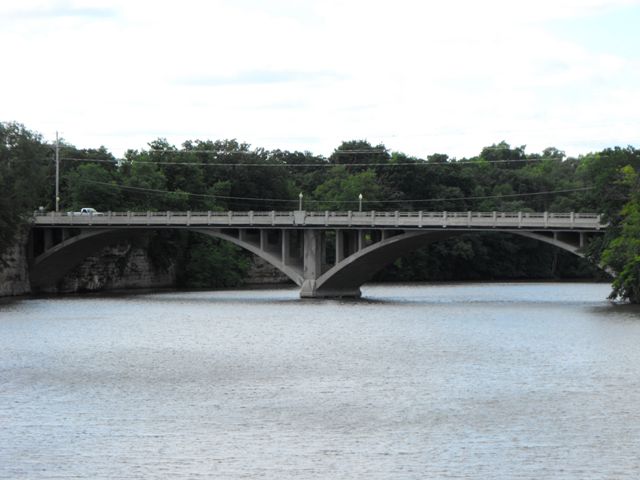We Recommend:
Bach Steel - Experts at historic truss bridge restoration.
Washington Avenue Bridge
Iowa Bridge Number 27000

Primary Photographer(s): Nathan Holth and Rick McOmber
Bridge Documented: July 1, 2009
Iowa Falls: Hardin County, Iowa: United States
Concrete Open Spandrel Deck Arch, Fixed and Approach Spans: Concrete Deck Girder, Fixed
1934 By Builder/Contractor: Welden Brothers Construction Company of Iowa Falls, Iowa
Not Available or Not Applicable
173.0 Feet (52.7 Meters)
380.0 Feet (115.8 Meters)
24 Feet (7.32 Meters)
2 Main Span(s) and 1 Approach Span(s)
27000

View Information About HSR Ratings
Bridge Documentation
View Archived National Bridge Inventory Report - Has Additional Details and Evaluation
Iowa Falls is a city that is known for its historic concrete arch bridges, with three open spandrel arch bridges in town all listed on the National Register of Historic Places, and indeed have been included as part of a historic tour. This is a historic bridge that fits in beautifully with its natural and man-made surroundings, including the scenic rocky Iowa River and the other historic arch bridges in town. Aside from the replacement of a deck and railings, this two-span bridge retains good historic integrity. This is the only one of the three arch bridges in the city that has two spans instead of just one. Up until 1995, this bridge carried an alignment of US-20. The relocation of US-20 to a freeway south of town undoubtedly was beneficial for the longevity of this bridge.
![]()
Photo Galleries and Videos: Washington Avenue Bridge
Bridge Photo-Documentation
Original / Full Size PhotosA collection of overview and detail photos. This gallery offers photos in the highest available resolution and file size in a touch-friendly popup viewer.
Alternatively, Browse Without Using Viewer
![]()
Bridge Photo-Documentation
Mobile Optimized PhotosA collection of overview and detail photos. This gallery features data-friendly, fast-loading photos in a touch-friendly popup viewer.
Alternatively, Browse Without Using Viewer
![]()
Maps and Links: Washington Avenue Bridge
Coordinates (Latitude, Longitude):
Search For Additional Bridge Listings:
Bridgehunter.com: View listed bridges within 0.5 miles (0.8 kilometers) of this bridge.
Bridgehunter.com: View listed bridges within 10 miles (16 kilometers) of this bridge.
Additional Maps:
Google Streetview (If Available)
GeoHack (Additional Links and Coordinates)
Apple Maps (Via DuckDuckGo Search)
Apple Maps (Apple devices only)
Android: Open Location In Your Map or GPS App
Flickr Gallery (Find Nearby Photos)
Wikimedia Commons (Find Nearby Photos)
Directions Via Sygic For Android
Directions Via Sygic For iOS and Android Dolphin Browser
USGS National Map (United States Only)
Historical USGS Topo Maps (United States Only)
Historic Aerials (United States Only)
CalTopo Maps (United States Only)


